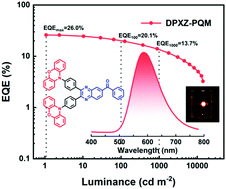Rational design of efficient orange-red to red thermally activated delayed fluorescence emitters for OLEDs with external quantum efficiency of up to 26.0% and reduced efficiency roll-off†
Abstract
The development of high efficiency orange-red/red thermally activated delayed fluorescence (TADF) organic light emitting diodes (OLEDs) with reduced efficiency roll-off remains a huge challenge. By fusing two weak electron-withdrawing benzoyl and quinoxaline units into one molecule, a strong π-accepting phenyl(quinoxalin-6-yl)methanone unit is introduced as an acceptor to develop three orange-red to red TADF emitters, (2-(4-(phenoxazin-10-yl)phenyl)quinoxalin-6-yl)phenylmethanone (PXZ-PQM), (2,3-bis(4-(phenoxazin-10-yl)phenyl)quinoxalin-6-yl)(phenyl)methanone (DPXZ-PQM) and (3,6-di(phenoxazin-10-yl)dibenzophenazin-11-yl)phenylmethanone (DPXZ-DPPM). By tuning the numbers of the donor and electron-withdrawing characteristics of the acceptor, the emission wavelength can be regulated from orange-red to red (592–642 nm). The rigid planar constituent moieties and highly twisted molecular structures induce high photoluminescence quantum yields of 61–88% in doped films and extremely small singlet–triplet energy splitting. The orange-red TADF-OLED using DPXZ-PQM as an emitter achieves a maximum external quantum efficiency (EQE) as high as 26.0% at 590 nm, which is among the highest EQE values reported for orange-red TADF-OLEDs with similar wavelengths. More importantly, a low efficiency roll-off is rendered with EQEs of 20.1 and 13.7% at a luminance of 100 and 1000 cd m−2, respectively.

- This article is part of the themed collection: Journal of Materials Chemistry C HOT Papers


 Please wait while we load your content...
Please wait while we load your content...